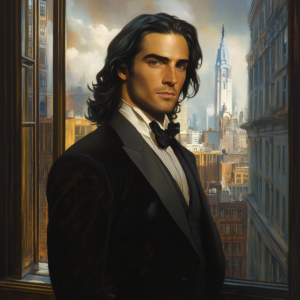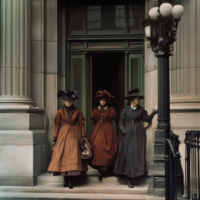📬 Welcome! I’m so glad you’re here.
This month, we’re talking about all kinds of great things. Do you love history? I do. While writing The Merchant Prince, which takes place in 1890 Philadelphia, I stumbled across some fascinating discoveries that I couldn’t wait to share.
👩🏭 Women in the Workforce – 1890 Snapshot
When someone read my book, they told me that in 1890, women didn’t really work. They said I could “get away with it” because it’s fiction, but that it wouldn’t be historically accurate.
I beg to differ.
📊 Percentage of Working Women
- Total U.S. population (1890): ~63 million
- Total female population: ~31.5 million
- Women in the workforce: ~4.8 million (about 18%)
🏭 Most Common Jobs for Women
- Domestic servants: ~1.3 million
- Textile/clothing factory workers: ~900,000
- Teachers: ~250,000
- Clerical workers (secretaries, typists, etc.): ~120,000
🧵 Top Jobs for Women Most women worked in roles considered “appropriate” at the time:
- Domestic service (42% of working women — maids, cooks, laundresses)
- Textile and garment work
- Agricultural labor
- Clerical work (an emerging field, considered respectable for educated women)
🎨 New & Unusual Fields A small but growing number of women were entering:
- Advertising
- Publishing & journalism
- Teaching and nursing
- Architecture, design, and art schools (just beginning to admit women)
📚 Education Matters
- By 1890, about 33% of American high school students were female.
- College attendance was rare — only about 2.2% of college-age women were enrolled.
🏙️ Women Living Alone
As women entered the workforce in larger numbers, many moved to cities for work and lived alone or with other women. Cities like Philadelphia became hubs for “working women’s boarding houses” and early apartment-style living.
🏠 Independent Living Was Becoming More Acceptable While still frowned upon by some, it was no longer shocking for a respectable woman to live alone. Some lived in boarding houses or “ladies’ residential hotels.” Others rented units in newly built apartment buildings — often small, shared, and designed specifically for working women.
In The Merchant Prince, Dorian Hathaway is a designer working for an advertising agency. She lives alone in a small apartment in a fictional suburb called Northern Lights — partly because she’s just a little too socially awkward to live with others.
🧩 Autism Spectrum in 1890 — and in Fiction


Both Robert Van Enger and Dorian Hathaway, the main characters in The Merchant Prince, would likely be considered to be on the autism spectrum if they lived today. I didn’t make this the focus of the story, but I did hint at it in their personalities.Robert is extremely intelligent, hyper-focused, and emotionally unmoved by social expectations. He also becomes obsessed with Dorian , in a quiet, protective way.
Dorian disappears into her own world when she’s creating. She walks to the market in the morning and sees nothing around her, completely absorbed in the designs in her head.
They were both ridiculed as children, but their parents shared the same defiant belief: “They’re just smarter than everyone else — and that makes people uncomfortable.”
🧠 Historical Figures Who May Have Been on the Spectrum
It’s only in recent years that we’ve started to look back and recognize autism traits in people from the past. A few who often come up:
🔬 Nikola Tesla
- Worked for 84 hours straight
- Sensory sensitivities and obsessive routines
- Socially isolated, never married
📚 Emily Dickinson
- Deep emotional sensitivity
- Intense focus
- Chose solitude over social life
🎩 Thomas Edison
- Called “addled” by his teachers
- Showed signs of hyperfocus and social disconnect
- Possibly ADHD, possibly autistic
⚖️ Sir Isaac Newton (earlier, but worth mentioning)
- Extremely focused
- Socially withdrawn
- Possibly on the spectrum by today’s understanding
💬 Final Thoughts
I just wanted to share this with you because sometimes we think we understand what the past was like, but when we dig deeper, we discover layers we never expected. And the further I go into history, the more I realize something quietly profound: People, at their core, haven’t changed all that much. Their struggles, hopes, fears, and quiet acts of bravery still echo through time — not so different from our own.
📖 If you’d like to read The Merchant Prince, you can get it here: 👉 https://www.amazon.com/dp/B0DWKRSY24
In other news. . .
In my last newsletter, I shared a deleted chapter from Echoes of Danger — a scene that didn’t make it into the final manuscript but still has a special place in my heart. I’m hard at work on the full book now, almost finished, and can’t wait to tell you more in the next newsletter. If you enjoy Western romance with suspense and heart, Books 1 and 2 are already available.https://www.amazon.com/dp/B0D955D4MS
Please join my newsletter and get these in your inbox about once a month. Subscribe to Newsletter
Thank you so much for being here, and let me know what you think. Until next time, —Helen
